What Are Light White Clouds Around Again
Gunkhole Rubber is a community supported site. We may earn commission from links on this page, but nosotros have confidence in all recommended products.
A boat on the water is a great identify to watch clouds. It's likewise a pleasant way to pass the time when you are bored. Information technology tin can also save you and your family from being caught in a sudden thunderstorm. A skipper knows to always cheque the weather forecast before leaving the dock, merely sometimes weather condition changes happen very rapidly. Y'all tin can "proceed a weather middle" by watching clouds and paying attention to changes in the wind and the seas.
When I first started to learn nigh clouds, I plant all the names confusing and difficult to remember. So I developed my ain arrangement for classifying clouds. (If you have your own system, let u.s.a. know and nosotros'll put information technology upwards hither.)
First y'all demand to place clouds by their shape. There are actually ten different types of clouds, but for now we'll concentrate on two basic shapes . The starting time blazon looks similar spoonfuls of marshmallow cream or cool whip (cool whip = cumulus). These are Cumulus clouds and they are puffy. Cumulus clouds tin can look like animals or people. The other shape of clouds is pretty apartment and directly – your plain old white bread clouds (direct = stratus). Stratus clouds are apartment (like breadstuff) and tin can be layered or sparse and wispy.
Tempest Deject Names
 Cumulus means "heap, a pile, an aggregating"
Cumulus means "heap, a pile, an aggregating"
I remember cumulus because they remind me of absurd whip.
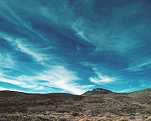 Stratus ways "spread out, flatten, encompass with a layer"
Stratus ways "spread out, flatten, encompass with a layer"
Flat and straight = stratus
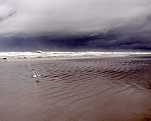 Nimbus means "rainy cloud". Nimbus clouds tin be either cumulus (puffy) or stratus (flat).
Nimbus means "rainy cloud". Nimbus clouds tin be either cumulus (puffy) or stratus (flat).
That part'southward pretty easy. The other thing you demand to know is the tiptop of the clouds. In that location are iii catagories of heights:
| Cloud Group | Cloud Top | Cloud Types |
|---|---|---|
| Loftier Clouds = Cirrus | In a higher place 18,000 feet | Cirrus Cirrostratus Cirrocumulus |
| Heart Clouds = Alto | half dozen,500 feet to 18,000 feet | Altostratus Altocumulus |
| Low Clouds = Stratus | Up to 6,500 anxiety | Stratus Stratocumulus Nimbostratus |
and and then there are clouds that can grow from low to high:
| Clouds with vertical growth | Cumulus Cumulonimbus |
Names of specific types of clouds are created by combining the name of the cloud'southward shape with the name of the cloud'southward pinnacle.
Cirros (high) or Cirro tin can be used with cumulus (heap, puffy) to indicate a cirrocumulus or high, puffy cloud. It can likewise be used with stratus (flat, layered) as in cirrostratus to indicate a high, apartment or layered cloud.
Alto clouds can too be used with cumulus and stratus to indicate altocumulus and altostratus which are middle altitude puffy clouds and middle altitude apartment or layered clouds respectively.
Nimbo or nimbus might exist used with cumulus or stratus to indicate a deject formation that is producing rain. These clouds could be either cumulonimbus which would exist a puffy, vertically-rising rain cloud or nimbostratus which would be a sheet or apartment-looking rain cloud.
Then there's stratusstratus – low (stratus) and flat (stratus) – but since that is redundant, we merely call them stratus. (I just fabricated that up.)
Types Of Cirrus Clouds
High clouds to a higher place xviii,000 feet are cirrus clouds.
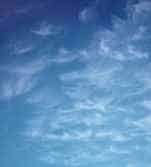
Cirrus clouds are the most mutual of the high clouds. They are equanimous of ice and consist of long, sparse, wispy streamers. Cirrus clouds are usually white and predict fair weather condition. Sometimes called mares tails, they stream with the wind. By watching the movement of cirrus clouds yous can tell from which direction weather is approaching. The appearance of cirrus clouds normally indicates that a change in weather will occur inside 24 hours.

Cirrostratus are sheetlike, sparse clouds that commonly encompass the unabridged sky. The sun or moon tin shine through Cirrostratus clouds. Cirrostratus clouds ordinarily come 12-24 hours before a pelting or snowfall storm.
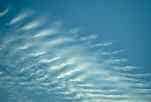 Cirrocumulus are minor, rounded puffs that usually appear in long rows. They are unremarkably white, but sometimes announced gray. Cirrocumulus are usually seen in the winter and indicate fair, but common cold, weather. In the tropics, they may signal an budgeted hurricane.
Cirrocumulus are minor, rounded puffs that usually appear in long rows. They are unremarkably white, but sometimes announced gray. Cirrocumulus are usually seen in the winter and indicate fair, but common cold, weather. In the tropics, they may signal an budgeted hurricane.
Types of Alto Clouds
Medium high clouds occupy altitudes of vi,500 anxiety to 18,000 anxiety . These clouds are chosen alto clouds. Alto clouds are used to predict weather condition changes in 6 to 12 hours.
 An Altostratus cloud usually covers the whole heaven. The cloud looks grey or blue-gray. The sunday or moon may smooth through an Altostratus cloud, just will appear hazy. An altostratus cloud usually forms alee of storms with continuous pelting or snow.
An Altostratus cloud usually covers the whole heaven. The cloud looks grey or blue-gray. The sunday or moon may smooth through an Altostratus cloud, just will appear hazy. An altostratus cloud usually forms alee of storms with continuous pelting or snow.
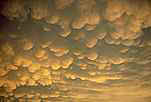 Altocumulus clouds are grayish-white with one part of the cloud darker than the other. Altocumulus clouds usually class in groups. If you see Altocumulus clouds on a warm, sticky forenoon, be prepared for thunderstorms by late afternoon.
Altocumulus clouds are grayish-white with one part of the cloud darker than the other. Altocumulus clouds usually class in groups. If you see Altocumulus clouds on a warm, sticky forenoon, be prepared for thunderstorms by late afternoon.
Types Of Stratus Clouds
Low clouds, chosen stratus clouds, are at altitudes up to 6,500 anxiety . These clouds course a solid sheet or layer of cloud mass.

Stratus clouds are uniform gray in color and almost comprehend the entire sky. Light mist or drizzle is sometimes associated with Stratus clouds. A Stratus deject touching the ground is fog.
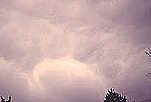 Stratocumulus clouds are low, puffy and greyness. Most form in rows with blueish heaven visible in betwixt. Rain rarely occurs with Stratocumulus clouds, however, they tin can plow into Nimbostratus.
Stratocumulus clouds are low, puffy and greyness. Most form in rows with blueish heaven visible in betwixt. Rain rarely occurs with Stratocumulus clouds, however, they tin can plow into Nimbostratus.
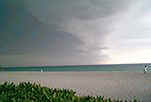
Nimbostratus clouds are dark gray with a ragged base. Rain or snow is associated with Nimbostratus clouds.
Clouds With Vertical Growth

Vertically developing clouds are the Cumulus (puffy) type. These small, lumpy clouds are low "off-white conditions" clouds. Even so, as they develop vertically (up) they may go from small, fair weather clouds to big, boiling, vertically-growing monsters called cumulonimbus.
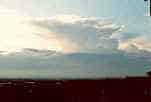
Cumulonimbus are by and large known as thunderstorm clouds. High winds will flatten the top of the cloud into an anvil-similar shape. Cumulonimbus are associated with heavy rain, snow, hail, lightning, and tornadoes. The anvil unremarkably points in the direction the storm is moving.
What Are Storm Clouds Called?
If you nevertheless can't remember all of the cloud names and formations, y'all can always watch the clouds for two things that indicate a loftier probability of a storm:
A "lowering ceiling": This means that the height of the stratus clouds (flat clouds) gets lower and lower. As the ceiling lowers you volition see types of storm clouds in the following order:
Cirrus
Cirrostratus
Altostratus
Stratus
Nimbostratus – storm clouds!
If you come across this happening, calmly tell the skipper "I believe we should caput dorsum now because I have observed increasingly lower cloud formations from cirrostratus to altostratus to stratus – and you know what THAT means!" (Right!)
Sentry for cumulus (puffy) clouds that offset to chop-chop develop vertically (up) to become cumulonimbus thunderstorm clouds. On hot and humid days, these storms occur over water equally the radiant heat from the land absorbs moisture from nearby water and rises to produce thunderheads.
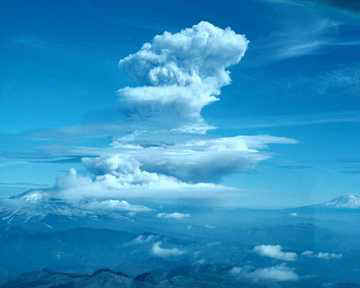
This is an example of a cumulus cloud that is growing vertically (up). The bottom of the cloud is made of h2o droplets and the meridian is made of ice crystals.
The cloud may be described equally "humid" but not considering it's hot. Parts of the cloud roll in a round movement, much like humid water.
A thunderstorm could develop very speedily.
To sum it up; flat clouds getting lower or puffy clouds getting higher – keep your eye out for a storm.
Other things to look for that indicate an budgeted conditions alter:
Weather changes generally come from the westward/southwest so scan the sky with your conditions center, especially to the west.
A sudden drop in temperature and alter in the wind (increasing winds and/or seas) oft means that a tempest is about.
If you have a barometer on your boat bank check it every two to three hours. A rapid drib in pressure means a tempest is approaching.
IF A Tempest IS NEAR the near important affair for y'all to practise is PUT ON YOUR LIFE JACKET. Stay depression in the boat and then you lot don't get a lightning rod! Assistance the skipper by maintaining a picket for other boats and floating stuff in the h2o and by fastening down loose gear, hatches and ports.
Storm Cloud Names: The Types Of Storm Clouds To Worry About
While at that place are a number of factors that could lead to a storm, there two things you should really continue an eye on: the types of pelting clouds that are floating around, and at what peak they're floating at. If you're looking at apartment clouds that are of a sudden getting lower, or watching puffy clouds getting fifty-fifty higher, then a storm could be heading your way.
Set your VHF radio to your local weather channel and heed out for any storm warnings, put your life jacket on, and keep your bilge pump on standby. Yous may be in for some heavy weather.
Source: https://www.boatsafe.com/storm-spotter/
0 Response to "What Are Light White Clouds Around Again"
Post a Comment